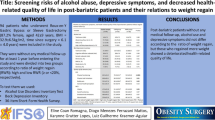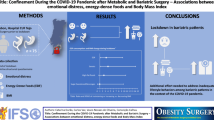Abstract
Background
Fatty acid (FA) profile is often altered, in morbidly obese subjects, both before and after bariatric surgery. We measured FA plasma levels before and 6 months after Roux-en-Y gastric bypass (RYGB), in order to evaluate their relationship with different biological and psychological parameters and the impact of RYGB on the FA plasma levels.
Methods
Thirty eight morbidly obese patients were investigated before RYGB, and 28 of them were reexamined 6 months postoperatively. Anxiety, depression, and quality of life were evaluated by validated questionnaires. Plasma FA (saturated, monounsaturated, polyunsaturated ω-6 and ω-3), vitamins A and E, fasting insulinemia, and high-sensitive C-reactive protein (hs-CRP) were measured.
Results
Before surgery, ω-3 polyunsaturated FA and vit A showed significant negative relationship with fasting insulinemia (γ-linolenic p = 0.03, eicosapentaenoic, vit A p = 0.01) and hs-CRP (eicosapentaenoic p = 0.03, vit A p = 0.02) and a positive link with HDL cholesterol (γ-linolenic p = 0.03, vit A p = 0.02). Depression score was significantly and negatively linked with palmitoleic (p = 0.03), γ-linolenic (p = 0.006), dihomo-γ-linolenic (p = 0.02), and α-linolenic (p = 0.03) acids. After surgery, FA and both vit A and E were significantly reduced. Vit A levels were below 2.4 μmol/l in 63 % of the patients, preoperatively, and in 79 % after surgery. Preoperative levels of linoleic acid were significantly related with the postoperative weight reduction (p = 0.0006).
Conclusions
FA are involved in several biological and psychological functions. The RYGB-induced reduction of FA could have deleterious consequences on vitamin absorption, metabolism, and depression. Thus, the surveillance of FA levels is of primary importance both before and after RYGB.



Similar content being viewed by others
References
Sturm R, Hattori A. Morbid obesity rates continue to rise rapidly in the United States. Int J Obes (Lond). 2013;37:889–91.
Lohrmann D, YoussefAgha A, Jayawardene W. Trends in body mass index and prevalence of extreme high obesity among Pennsylvania children and adolescents, 2007–2011: promising but cautionary. Am J Public Health. 2014;104:e62–8.
Hubert HB, Feinleib M, McNamara PM, et al. Obesity as an independent risk factor for cardiovascular disease: a 26-year follow-up of participants in the Framingham Heart Study. Circulation. 1983;67:968–77.
Jagielski AC, Brown A, Hosseini-Araghi M, et al. The association between adiposity, mental well-being, and quality of life in extreme obesity. PLoS One. 2014;9:e92859.
Sjostrom L. Review of the key results from the Swedish Obese Subjects (SOS) trial—a prospective controlled intervention study of bariatric surgery. J Intern Med. 2013;273:219–34.
Aftab H, Risstad H, Sovik TT, et al. Five-year outcome after gastric bypass for morbid obesity in a Norwegian cohort. Surg Obes Relat Dis. 2014;10:71–8.
Madan AK, Orth WS, Tichansky DS, et al. Vitamin and trace mineral levels after laparoscopic gastric bypass. Obes Surg. 2006;16:603–6.
Bal BS, Finelli FC, Shope TR, et al. Nutritional deficiencies after bariatric surgery. Nat Rev Endocrinol. 2012;8:544–56.
Lorente-Cebrian S, Costa AG, Navas-Carretero S, et al. Role of omega-3 fatty acids in obesity, metabolic syndrome, and cardiovascular diseases: a review of the evidence. J Physiol Biochem. 2013;69:633–51.
Rizos EC, Ntzani EE, Bika E, et al. Association between omega-3 fatty acid supplementation and risk of major cardiovascular disease events: a systematic review and meta-analysis. JAMA. 2012;308:1024–33.
Ernst B, Thurnheer M, Schmid SM, et al. Evidence for the necessity to systematically assess micronutrient status prior to bariatric surgery. Obes Surg. 2009;19:66–73.
Damms-Machado A, Weser G, Bischoff SC. Micronutrient deficiency in obese subjects undergoing low calorie diet. Nutr J. 2012;11:34.
Kimmons JE, Blanck HM, Tohill BC, et al. Associations between body mass index and the prevalence of low micronutrient levels among US adults. MedGenMed. 2006;8:59.
Correia Horvath JD, Dias de Castro ML, Kops N, et al. Obesity coexists with malnutrition? Adequacy of food consumption by severely obese patients to dietary reference intake recommendations. Nutr Hosp. 2014;29:292–9.
Ju SY, Lee YJ, Jeong SN. Serum 25-hydroxyvitamin D levels and the risk of depression: a systematic review and meta-analysis. J Nutr Health Aging. 2013;17:447–55.
Murakami K, Miyake Y, Sasaki S, et al. Fish and n-3 polyunsaturated fatty acid intake and depressive symptoms: Ryukyus Child Health Study. Pediatrics. 2010;126:e623–30.
Grosso G, Pajak A, Marventano S, et al. Role of omega-3 fatty acids in the treatment of depressive disorders: a comprehensive meta-analysis of randomized clinical trials. PLoS One. 2014;9:e96905.
Zigmond AS, Snaith RP. The hospital anxiety and depression scale. Acta Psychiatr Scand. 1983;67:361–70.
Kolotkin RL, Crosby RD, Williams GR. Health-related quality of life varies among obese subgroups. Obes Res. 2002;10:748–56.
Chajes V, Hulten K, Van Kappel AL, et al. Fatty-acid composition in serum phospholipids and risk of breast cancer: an incident case–control study in Sweden. Int J Cancer. 1999;83:585–90.
Gueguen S, Herbeth B, Siest G, et al. An isocratic liquid chromatographic method with diode-array detection for the simultaneous determination of alpha-tocopherol, retinol, and five carotenoids in human serum. J Chromatogr Sci. 2002;40:69–76.
Tanskanen A, Hibbeln JR, Tuomilehto J, et al. Fish consumption and depressive symptoms in the general population in Finland. Psychiatr Serv. 2001;52:529–31.
Astorg P, Couthouis A, Bertrais S, et al. Association of fish and long-chain n-3 polyunsaturated fatty acid intakes with the occurrence of depressive episodes in middle-aged French men and women. Prostaglandins Leukot Essent Fat Acids. 2008;78:171–82.
Lucas M, Mirzaei F, O’Reilly EJ, et al. Dietary intake of n-3 and n-6 fatty acids and the risk of clinical depression in women: a 10-y prospective follow-up study. Am J Clin Nutr. 2011;93:1337–43.
Rogers PJ, Appleton KM, Kessler D, et al. No effect of n-3 long-chain polyunsaturated fatty acid (EPA and DHA) supplementation on depressed mood and cognitive function: a randomised controlled trial. Br J Nutr. 2008;99:421–31.
Zhao G, Ford ES, Dhingra S, et al. Depression and anxiety among US adults: associations with body mass index. Int J Obes (Lond). 2009;33:257–66.
Robinson LE, Buchholz AC, Mazurak VC. Inflammation, obesity, and fatty acid metabolism: influence of n-3 polyunsaturated fatty acids on factors contributing to metabolic syndrome. Appl Physiol Nutr Metab. 2007;32:1008–24.
Devaraj S, Singh U, Jialal I. Human C-reactive protein and the metabolic syndrome. Curr Opin Lipidol. 2009;20:182–9.
Liukkonen T, Silvennoinen-Kassinen S, Jokelainen J, et al. The association between C-reactive protein levels and depression: results from the northern Finland 1966 birth cohort study. Biol Psychiatry. 2006;60:825–30.
Kalupahana NS, Claycombe K, Newman SJ, et al. Eicosapentaenoic acid prevents and reverses insulin resistance in high-fat diet-induced obese mice via modulation of adipose tissue inflammation. J Nutr. 2010;140:1915–22.
Raju M, Lakshminarayana R, Krishnakantha TP, et al. Micellar oleic and eicosapentaenoic acid but not linoleic acid influences the beta-carotene uptake and its cleavage into retinol in rats. Mol Cell Biochem. 2006;288:7–15.
Mercader J, Ribot J, Murano I, et al. Remodeling of white adipose tissue after retinoic acid administration in mice. Endocrinology. 2006;147:5325–32.
Landrier JF, Marcotorchino J, Tourniaire F. Lipophilic micronutrients and adipose tissue biology. Nutrients. 2012;4:1622–49.
Gey KF, Ducimetiere P, Evans A, et al. Low plasma retinol predicts coronary events in healthy middle-aged men: the PRIME Study. Atherosclerosis. 2010;208:270–4.
Frey SK, Vogel S. Vitamin A metabolism and adipose tissue biology. Nutrients. 2011;3:27–39.
Bobbioni-Harsch E, Huber O, Morel P, et al. Factors influencing energy intake and body weight loss after gastric bypass. Eur J Clin Nutr. 2002;56:551–6.
Koba K, Akahoshi A, Yamasaki M, et al. Dietary conjugated linolenic acid in relation to CLA differently modifies body fat mass and serum and liver lipid levels in rats. Lipids. 2002;37:343–50.
Vaughan RA, Garcia-Smith R, Bisoffi M, et al. Conjugated linoleic acid or omega 3 fatty acids increase mitochondrial biosynthesis and metabolism in skeletal muscle cells. Lipids Health Dis. 2012;11:142.
Onakpoya IJ, Posadzki PP, Watson LK, et al. The efficacy of long-term conjugated linoleic acid (CLA) supplementation on body composition in overweight and obese individuals: a systematic review and meta-analysis of randomized clinical trials. Eur J Nutr. 2012;51:127–34.
Dailey MJ, Moghadam AA, Moran TH. Jejunal linoleic acid infusions require GLP-1 receptor signaling to inhibit food intake: implications for the effectiveness of Roux-en-Y gastric bypass. Am J Physiol Endocrinol Metab. 2011;301:E1184–90.
Conflict of Interest
All authors declare no conflict of interest.
Statement of Informed Consent
Informed consent was obtained from all individual participants included in the study.
Statement of Human and Animal Rights
All procedures performed in this study were in accordance with the ethical standards of the institutional and/or national research committee and with the 1964 Helsinki Declaration and its later amendments or comparable ethical standards.
Author information
Authors and Affiliations
Corresponding author
Rights and permissions
About this article
Cite this article
Chalut-Carpentier, A., Pataky, Z., Golay, A. et al. Involvement of Dietary Fatty Acids in Multiple Biological and Psychological Functions, in Morbidly Obese Subjects. OBES SURG 25, 1031–1038 (2015). https://doi.org/10.1007/s11695-014-1471-z
Published:
Issue Date:
DOI: https://doi.org/10.1007/s11695-014-1471-z




